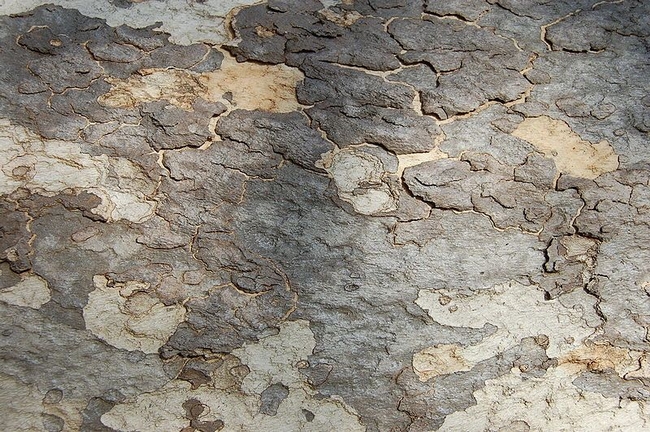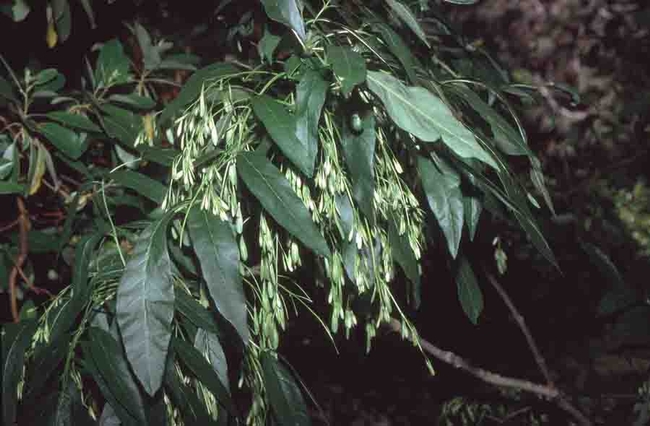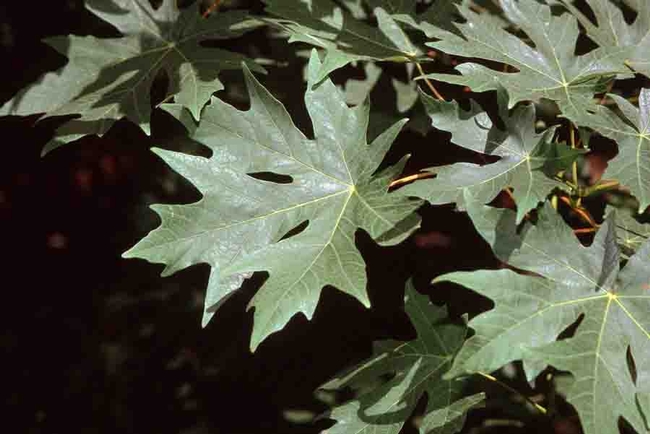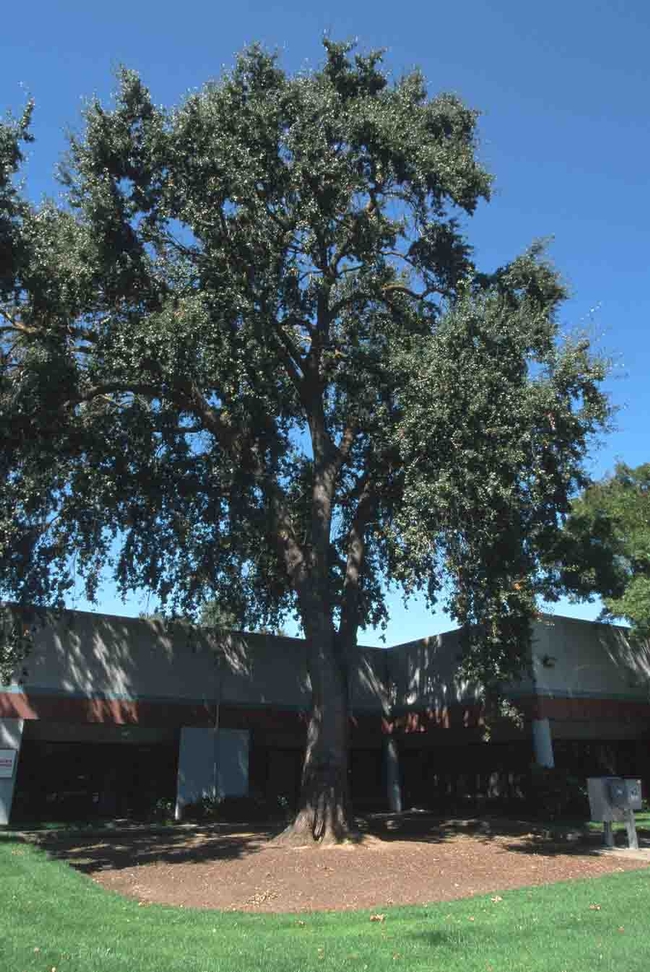Fall is an excellent time to plant trees and shrubs. The soil is still warm, so roots will have time to establish themselves long before the punishing heat of next summer arrives. If you are thinking of planting a large tree, here are several to consider. They all flourish on land next to Chico's Lindo Channel.
Also known as Sandy Gulch, the Lindo Channel is a seasonal waterway that serves as a flood control channel. The soil has significant percentages of sand and cobble, further enhancing summer dryness. Since moving beside the Channel in 1991, I have established a drip irrigation system to help establish native plants on the bank.
Large trees are highly effective features in a landscape, but are also useful in creating a high canopy so that a variety of plants (including shade plants) can grow underneath, and in providing substantial habitat for wildlife. Western Sycamore, Oregon Ash, Big Leaf Maple, and Valley Oak do well in the Lindo Channel environment.
Western Sycamore

Because their roots go down, not out, if given enough water, they are good trees near patios or in urban environments. They grow quickly (up to 30 feet in five years). Eventual height can reach 115 feet, but more commonly 65-85 feet, with a trunk diameter up to three feet. The trunk generally divides into two or more large trunks, each splitting into many branches. The bark is multi-colored, with splashes of white, pinkish gray and pale tan. The older bark becomes darker and peels away. Leaves are up to 10 inches wide. After a good rain, the leaves produce a fresh, earthy scent.
Western Sycamore trees are deciduous, with leaves turning yellow and orange-brown in the fall. Flowers are one-inch spheres that become seed balls. Western Sycamores are tough and easy to grow: they will tolerate a wide variety of soils and pH levels and prefer full sun, but they do need a lot of water.
They are important hosts for Western Tiger Swallowtail and other butterflies, hummingbirds, finches, waxwings, and pine siskins. Hummingbirds use the down from stems and leaves to line their nests. They are deer resistant trees, but are susceptible to anthracnose fungus (leaf blight) if it rains when leaves are expanding. The disease causes disfiguration of the leaves in mild cases and leaf loss in severe cases.
For more information on Western Sycamore, see Calscape-Western Sycamore.
Oregon Ash

It grows quickly to 75 feet in height and 16 to 30 feet in diameter. Long-lived and easy to care for, this tree likes moist to wet soils, including heavy soils near streams, lakes and in flood plains, in sun to partial shade. It also grows on sandy, rocky, and gravelly soils in riparian areas (near river banks) or areas with seasonal flooding. Foliage turns bright yellow in fall.
Seeds are single samaras (fibrous wings of papery tissue), with long wings (up to two inches) borne in large, drooping clusters on female trees. These are eaten by birds and small mammals, while the foliage provides sustenance for the larvae of pale swallowtail, two-tailed swallowtail, and western tiger swallowtail butterflies.
Oregon Ash trees are susceptible to caterpillars and scales, anthracnose, root rot, rust, sooty mold and verticillium wilt.
For more information on Oregon Ash, see Calscape-Oregon Ash.
Big Leaf Maple

Growth is very fast at first, to 50 to 65 feet, eventually reaching up to 160 feet with a trunk diameter of 12 to 36 inches. The 4-to-6-inch clusters of greenish-yellow flowers appear with leaves in the spring. Leaves are 6 to 12 inches across. In fall, they turn gold to orange-yellow.
Big Leaf Maple trees are long-lived. These are good native trees near lawns; they need lots of water for the first year or so. They are not as tolerant of wet soils as ash trees and can be drought tolerant in their native range. Tolerant of soils with serpentine and clay; will survive (though not at best) in sandy soil.
The seeds, buds and flowers of Big Leaf Maple are a favorite food of many small mammals and birds. Speciesassociated with Big Leaf Maple are evening and blackheaded grosbeaks, goldfinches, pine siskins, warblers, vireos, bushtits and kinglets.
For more information on Big Leaf Maple, see Calscape-Big Leaf Maple.
Valley Oak

The Valley Oak (Quercus lobata)is native to riparian areas of the Central Valley, the valleys of the Sierra foothills, and the coast ranges of California. The fastest growing (3 to 4 feet per year) of California oaks, it is deciduous and can grow to 70 feet. With age, the branches are irregular and spreading. Leaves are deeply lobed.
Valley oaks like sun and moderate water with a water table above 70 feet. Do not water established oaks. They are long-lived and tolerant of seasonal flooding and a variety of soils (though they prefer deep soils with pH of 6 to 8). These trees are deer resistant.
Valley Oaks provide nesting sites for birds, and are popular with insects year-round and with the birds that eat them (including bluebirds, warblers, phoebes, flycatchers, vireos, swallows, and titmice). This tree hosts numerous species of butterfly, including California sister, propertius duskywing, mournful duskywing, golden hairstreak, and gold Hunter's hairstreak.
The acorns of the Valley Oak are a staple food of the acorn woodpecker, but a variety of mammals and birds also eat them, including scrub jays, yellow-billed magpie, deer, bears, and squirrels.
For more information on Valley Oak, see Calscape-Valley Oak.
Next week, this column will focus on large native shrubs and small trees that thrive beside the Lindo Channel.
UC Master Gardeners of Butte County are part of the University of California Cooperative Extension (UCCE) system. To learn more about us and our upcoming events, and for help with gardening in our area, visit our website. If you have a gardening question or problem, email the Hotline at mgbutte@ucanr.edu or leave a phone message on our Hotline at (530) 538-7201. To speak to a Master Gardener about a gardening issue, or to drop by the MG office during Hotline hours, see the most current information on our Ask Us Hotline webpage.